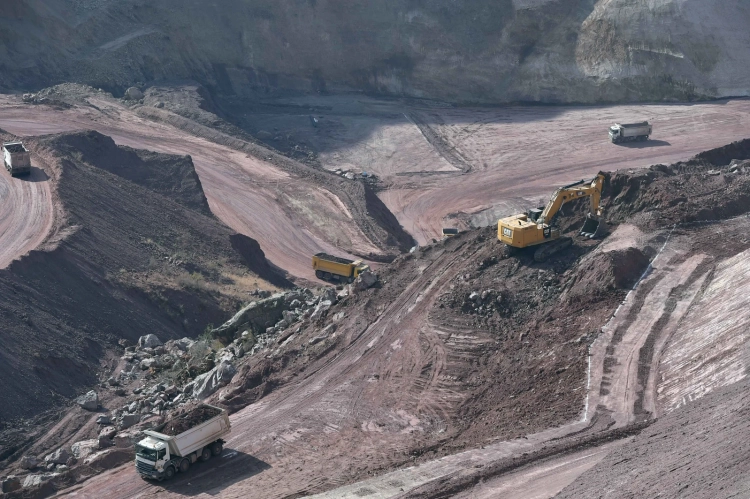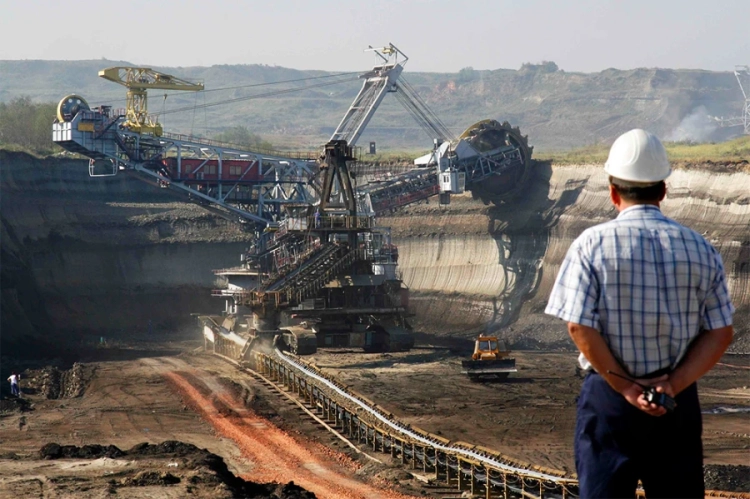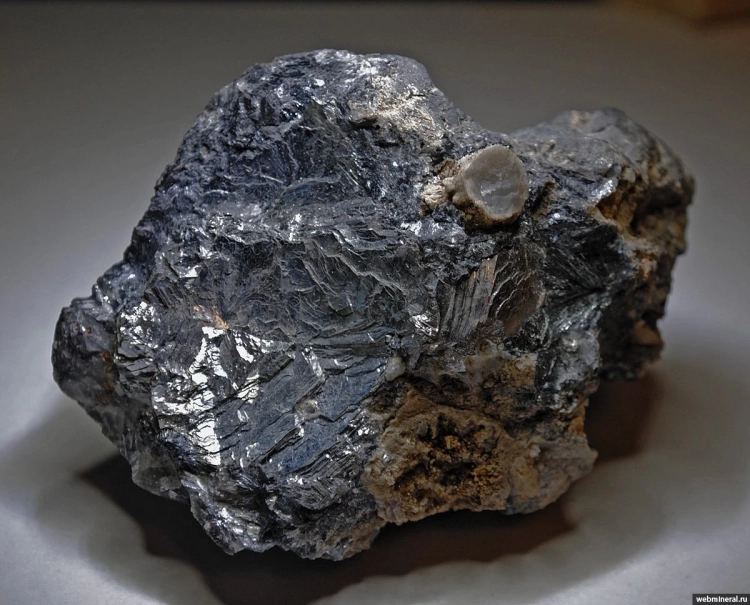The traces of ancient mining operations in the territory of Kyrgyzstan indicate that mercury, lead, zinc, gold, copper, etc. have been extracted here since ancient times. The volume of extraction of certain minerals speaks to a significant level of work during those times (for example, at the lead mines of Kana and Guta). Gold was historically mined in the Turkestan Range, in Chatkal, Uzun-Akmate, Talas, Suusamyr, Issyk-Kul, and other places. Before the collapse of the USSR, Kyrgyzstan was considered a major producer of antimony, mercury, and rare earth elements. Before World War II, mining operations began at the Kadamjai antimony deposit. Mercury extraction was also established (Haiderken, Chauvay, Simap, and other deposits); tungsten, gold, lead, zinc (Meshked, Kum-Bel, Kulja-Bashat, etc.); and others. After the war, industrial extraction of mercury, antimony, zinc, silver (Ak-Tyuz, Sumsar, Kanigut, Granitogorsk), uranium (Min-Kush, Kazy-Sai, Shakafatar, Mailuu-Suu) was organized, and in the late 1950s, polymetallic extraction began. Coal was initially mined at the Sylyuktin and Kyzyl-Kyys deposits (2nd half of the 19th century). The Kyok-Jangak coal deposit was put into operation in 1910, and the Tash-Kyomur deposit in 1916. In 1913, there were 27 coal mines operating in Kyrgyzstan, with the volume of coal extracted accounting for 70% of all coal production in Central Asia. The volume of coal extraction in the largest mine reached 100,000 tons.
In the current development of the republic's economy, the mining and metallurgical complex holds a special place. Its enterprises provide jobs for about 45,000 people, and their fixed assets account for 15.4%. Despite some achievements in the extraction of mercury and gold, the overall situation in this sector remains extremely difficult. Due to a lack of funds for mining operations in the context of transitioning to market relations, the activities of some enterprises in the mining complex have been suspended.
The volume of production in the metallurgical industry from 1994 to 1999 increased 7.1 times due to the launch of the Kumtor gold mine and subsequent refining of the extracted gold at the Kara-Baltinsky mining and metallurgical plant, while exports in 1999 decreased by 30% compared to 1998.
In 2000, the mining industry produced goods worth 9,775.1 million soms, of which 95.3% was accounted for by the extraction of non-ferrous metals. The physical growth index was 107.7%. A total of 414.9 thousand tons of coal were extracted, an increase of 0.6% compared to 1999. Due to a lack of financial resources for the opening of upper soil layers and mining workings, fuel and lubricants, wooden materials, equipment, and spare parts, coal extraction at the LLC "Tegene" decreased by 3.8%, while at the JSC "Kyok-Jangak" it dropped by 86.1%. Oil and natural gas extraction amounted to 103%. The production of liquid metals increased by 1.5 times, oxides by 33.7%, alloys of metals and antimony by 14%, while mercury production decreased by 14.9%.
At the launched Makmal plant in 1986, 2.1 tons of gold were extracted in 2000. In 1996, the most powerful joint venture in the republic, "Kumtor Gold Operating Company," was established, with founders being Kyrgyzstan and the Canadian state-private corporation "Cameco." According to the agreement, 2/3 of the extracted gold goes to the republic, and 1/3 to "Cameco." The plant is equipped with the latest technology. The joint venture sold 20.3 tons of gold worth 221.4 million US dollars in 1998. After paying interest on received loans and development costs, the net profit amounted to 1.2 million US dollars, which is 46.1%. The corporation "Cameco," which is developing the Kumtor gold deposit, intends to increase annual gold production to 30 tons. Currently, the joint venture "Kumtor Gold Operating Company" is exempt from state taxes and plans to extract 150 tons of gold over the next 5 years.
In the high mountainous part of the Talas region lies the Jeruy gold deposit, where since 1997, the well-known Australian company "Normandy Mining Limited" has been conducting pre-project studies in collaboration with the state concern "Kyrgyzaltyn." It is expected to extract 5-6 tons of gold per year, which requires attracting foreign investments of over 100 million US dollars.
For geological exploration work in the area of the Solton-Sary deposit, located in the Inner Tien Shan, foreign companies and the state concern "Kyrgyzaltyn" have spent 8 million US dollars.

To develop the Chui gold deposit, the Taldy-Bulak-Left Bank Kara-Baltin Mining and Metallurgical Plant and the mining corporation "Berhard" from Malaysia created a joint venture, which conducted project and survey work for the technical and economic justification. The Canadian firm "Kilborn" was also involved in the work. Approximately 80 million US dollars in foreign investments will be required to develop this deposit. Once operational, the enterprise will produce 5-6 tons of gold per year.
The Kum-Bel and Chatkal deposits are expected to be developed with the help of American firms.
The state concern "Kyrgyzaltyn" extracted 61.5 kg of gold from 12 placer deposits. Due to falling gold prices and rising costs of services, equipment, spare parts, and materials, extraction at such enterprises has been deemed unprofitable, and operations have been halted.
The Agency for Geology and Mineral Resources, together with "TEC Corporation," is conducting work with total expenses of 1.5 million US dollars in Kemine, in northern Talas, Burkan-Sonkole. Work is also ongoing in collaboration with the British company "SVM" in the territory of "Andash" (for 400 thousand US dollars), with the international company "Kumushtag" at the "Jamgyr" site (1 million US dollars), and exploratory work with the Dutch-American company "Chemco" at the "Unkyurtash" site (400 thousand US dollars). With a grant from the Japanese government, work is being conducted at the "Shyralzhy" gold deposit costing 700 thousand US dollars, and in the Sukh region, 500 thousand US dollars have been spent on exploration since 1997.
The gold extracted from all deposits in the republic is sent for refining at the Kara-Baltin Mining and Metallurgical Plant. In collaboration with the English firm "Mekomin," the plant produces molybdenum and its compounds, and primarily processes uranium concentrates, which generates the main profit (in 2000, the profit amounted to 10 million soms).
The Kadamjai antimony plant consists of the Kadamjai and Terek-Sai mines and a metallurgical plant. It was founded in 1936 as a pilot industrial plant. Currently, raw materials come from Tajikistan (Zhizikrut), Sakha-Yakutia, and Kazakhstan. The plant produces metallic antimony and its alloys. In the former USSR, the plant was considered one of the most advanced in the country. Kyrgyz antimony was distinguished by its high quality, winning a Grand Gold Medal at the World Exhibition in Brussels in 1958 and recognized as a standard of pure metal. Kyrgyzstan is a monopoly in the CIS for antimony production. In 1990, the republic produced 5,400 tons of antimony, ranking third after China and Bolivia. In 1995, 4,778 tons were produced (6,637 tons in 1993), with 6,283.4 tons exported (11,448.3 tons) respectively. If in 1995 the plant's balance profit was 170 million soms, by the third quarter of 1999, losses amounted to 25 million soms. The reason for such a dire situation is the decline in world prices for antimony.
The Haidarken state joint-stock company, founded in 1942 as a mercury plant, includes several mines and a metallurgical plant. In 1990, 1,000 tons of mercury were produced. In subsequent years, production significantly decreased. For example, in 1995, only 185.9 tons were obtained (577 tons in 1997), with 261.1 tons (499.2 tons) exported. In 2000, 33.8 tons of mercury were produced, worth 64,275 thousand soms (in 1999, 60,123 thousand soms). In the JSC in 2000, 1,032 people were employed. Due to significant difficulties in extracting mercury-containing ores, a decision was made to extract mercury from mercury-contaminated water brought from abroad. However, since this process severely worsens the ecological situation in the region, there are currently plans to resume operations at the Uluu-Too mine. Despite this, the republic's position in the world mercury market is satisfactory, as it meets the needs of China and India. At the same time, there is a trend of declining mercury prices.
The JSC "Kyrgyz Chemical and Metallurgical Plant" was established in 1995 on the basis of facilities for processing rare earth element concentrates and semiconductor production of the Kyrgyz Mining and Metallurgical Plant (founded in 1953). It produces erbium, dysprosium, terbium, samarium, gadolinium, neodymium, yttrium, and monocrystalline silicon. The Ak-Tyuz management for ore extraction and enrichment, previously part of the plant, has been separated into an independent JSC. 70% of the shares (1 million soms) of the JSC "Ak-Tyuz" were acquired by the firm "Golden Silver" (Israel). Currently, work is being done to improve the sewage system, water wells, buildings, and waste treatment facilities. "Golden Silver" is making efforts not only to put the mine and enrichment plant into operation but also to create jobs for the population and solve social problems.
The republic has conditions for the development of the tin industry. The projected reserves of industrial tin are mainly located in the basin of the Sary-Jaz River. At one time, the construction of a metallurgical plant was started, which was then suspended. The complex includes an enrichment plant, the "Trudovoy" and "Uch-Koshkon" mines. In addition to tin, there are tungsten and molybdenum, so it needs to be developed comprehensively. The Indian company "Jackson International Limited," in collaboration with the Kara-Baltin Mining and Metallurgical Plant, conducted technical and economic calculations.

In Kyrgyzstan, there are 12 mining shafts and open pits in the coal industry, along with 5 auxiliary enterprises and nodes. Here, 4,080 people are employed, of which 3,400 work directly in coal extraction. In the republic, 550 thousand tons were extracted in 1998, 417 thousand tons in 1999, and 419.4 thousand tons in 2000. The volume of extraction has decreased compared to 1990. At the same time, the demand for coal is three times higher than the volume of extraction. The lag occurs due to a lack of material and financial resources. Most enterprises are in a loss-making state. Coal extraction in 1998 compared to 1997 was as follows: in the joint-stock company (JSC) "Kyzyl-Kiya" — 20.2%, JSC "Almaly Kyomur" — 38.8%, state joint-stock company "Tash-Kyomur" — 37.9%, GAK "Jyrgalan" - 16.8%. The reasons for the decline include: a shrinking coal market in Central Asia, a worsening financial climate, a transition of most consumers to other types of fuel, rising transportation costs, and aging mining and transport equipment.
Based on the recommendations of the PESAC program advisors, it was deemed impractical to operate the Kyzyl-Kyys mine named after the VLKSM, the Sylyuktin mine 6/18, and the "Borborduk" mine in the town of Kazy-Sai — all of which were closed. Operations at the Razakov mine (Sylyukt) and the "Northern" (Tash-Kyomur) and "Jyrgalan" mines in the Issyk-Kul region have been temporarily suspended. The average cost of coal extracted in the mines is higher than the average selling price. Only the open pits of GAK "Almalyk" and "Ak-Ulak" are considered profitable. To revive the coal industry, there is a need for extensive development of the Kara-Kechen brown coal deposit.
The demand of the population and industry of the republic for coal will be 2,270 thousand tons in 2001 and 3,160 thousand tons in 2005. To increase coal extraction, a complete reconstruction of coal mining enterprises is required.
In 1999, the oil balance was: by categories A + D + C, — 11,576 thousand tons, by category C2 — 1,592 thousand tons of recoverable reserves, geological reserves by categories A + D + C, — 88,395 thousand tons, by category C2 — 88,440 thousand tons. In 1998, the volume of commodity production in the oil and gas industry amounted to 388.6 million soms, or 117% compared to 1997, including: JSC "Kyrgyzmunaygaz" — 87.2 million soms and, respectively, 92%; JV "Kyrgyz Petroleum Company" — 301.4 million soms. Oil production in 1998 was 73.6 thousand tons, or 86% compared to 1997; natural gas — 17.9 million m³ or 75% of the 1997 level. The volume of drilling work is decreasing annually. The number of operating wells at the beginning of 1999 was 405, including 268 operational, and 137 inactive and idle. The financial indicators of JSC "Kyrgyzmunaygaz" remain low. Losses in 1998 amounted to 2.2 million soms. The Jalal-Abad oil refinery produced 37,233.7 tons of gasoline, 19,260.1 tons of diesel fuel, and 14,722.8 tons of fuel oil in 1998.















































